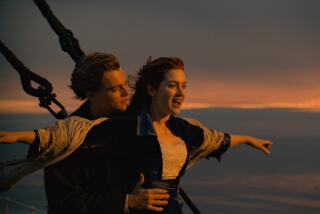Hollywood Bio Hazards
From Moses to Malcolm X, Virginia Woolf to Loretta Lynn, historic figures have been showing up on the big screen since the early days of silent film. This year, by nominating six biographical pictures for Oscars -- including three for best picture -- the Academy Awards folks have returned a neglected genre to prominence and given biographers like me the willies.
Biographical pictures place special demands on the actors, screenwriters and directors who make them. And this year’s crop -- “The Aviator,” “Ray” and “Finding Neverland,” for best picture, along with “Kinsey,” “Hotel Rwanda,” “The Motorcycle Diaries” (and even, as a stretch, “The Passion of the Christ”) -- the subjects are particularly tricky to portray in a medium as fickle and demanding as the movies.
As the author of several biographies of iconic American figures, I was curious about these movies and managed to see four of them -- or, as my daughter’s film professor would put it, I viewed the texts.
Normally, my critical standards for books are so high that they interfere with my simple enjoyment of whatever I happen to be reading. But my standards for movies are, in general, fairly low. All I seek is two hours of entertainment and escape, authenticity -- logic even -- be damned.
But “viewing” the “texts” of biographical movies put me in a quandary because my two very different sets of standards conflicted. I could hardly keep a straight face during the excesses and scenery chewing of “The Aviator,” for instance, yet I found it far more enjoyable than the carefully and logically wrought “Kinsey.” Yet “Kinsey” was the only movie -- I meant to say text -- from which I felt I learned anything worth knowing about its subject. The others amounted to varying degrees of escapism.
No one will deny that translating an entire life to the screen poses problems. Mark Twain, for one, believed it was impossible to be true to anyone’s life, even in book form, because the description of the events of only a few days would require many more pages than a reader would be willing to plow through. I believe Twain’s observation, a warning to all us biographers, goes double for movies, where the compression and stylization are so drastic.
To get around this problem, the biographical picture has evolved into a set of conventions as stylized and recognizable as kabuki theater. Orson Welles’ 1941 masterpiece, “Citizen Kane,” codified the rules and set the template, especially with its innovative use of “Rosebud” -- the term now used for any symbol or event that explains everything about a person for purposes of the movie.
As we all know, the original Rosebud was a sleigh belonging to the movie’s hero -- loosely based on newspaper magnate William Randolph Hearst -- which is consigned to the flames. Welles uses his symbol two ways, both as a symbol of Kane’s lifelong defiance and boyishness in the form of a sled, and, more elusively, as a delicate rosebud, an emblem, perhaps, of the fount of the most personal of all feelings.
Biographical movies have seized on Welles’ brilliant example and have often resorted to rosebuds of their own to explain the mysterious inner workings of their protagonists. With one prominent exception, the Oscar nominees I saw this year follow this convention.
Professor Alfred Kinsey’s rosebud, for example, is his father, the tragic minister played so hauntingly by John Lithgow. In the movie’s universe, Kinsey, portrayed by Liam Neeson, evolved from a professor of taxonomy into a sex researcher in reaction to his father’s pathological prudery, and that is all we need to know.
The biographer in me recognizes that real life is far more complex and nuanced than this simple theory suggests, and that Kinsey’s father’s personality is just one factor leading to his son’s preoccupation. Part of the fascination of written biographies is watching the protagonist evolve by increments from an apparently ordinary person into the historic figure we recognize, by running a gantlet of chance and circumstance. Movies don’t have time, and moviegoers, including myself, don’t have the patience to ponder all these ambiguities, so the rosebud device comes in handy to suggest a character’s driving force, in the interest of keeping the story moving swiftly forward.
“Ray” ranks as my favorite among the four biographical pictures I saw, owing in large part to Jamie Foxx’s electrifying impersonation of Ray Charles. This film flaunts an even niftier rosebud. The young Charles, in a moment of inattentiveness, unwittingly permits a tragic mishap. The irredeemable guilt engendered by this event, the movie tells us, drove Charles to the heights of musical expression and to the depths of despair, even drug addiction.
I have no idea if Charles himself subscribed to this theory, and as a biographer, I’m deeply skeptical of it, but as a dramatic device, a rosebud, I must admit it works powerfully and viscerally. It makes us think that at last we understand the key to Charles’ character, when the roots of musicians’ talent and inspiration are profoundly enigmatic.
“The Aviator” carries the rosebud idea almost to the point of parody, with its opening image of Howard Hughes’ mother washing the boy with excessively loving attention. This behavior, the movie suggests, is the reason for Hughes’ brilliance and for the obsessive-compulsive disorder that was his undoing, and although this device may work in theory, it didn’t begin to explain the motivations and innermost feelings of an actual person. It seemed more like the clever idea of an avid student of film.
In the end, the parts of “The Aviator” I found most appealing had little to do with fact and everything to do with fiction, especially his enchanting airplane ride over Beverly Hills with Katharine Hepburn. If not exactly educational, it was certainly diverting, and at times beguiling. Based on my understanding of Hughes, this was the least factual of the pictures I saw. It is also the most likely to win Oscars, I’m told, and I have to think there’s a connection between the heavy doses of fantasy and resulting nominations.
Of the four biographical pictures I saw, only “Finding Neverland” avoids the Wellesian model that both animates and distorts the others. With its measured consideration of tastefully chaste love (James Matthew Barrie conducts a quasi-affair with the dying Sylvia Llewelyn Davies, portrayed by Kate Winslet), and youthful imagination, this movie offers a more intelligent and humane alternative to the shamelessly manipulative antics of “The Aviator,” yet it comes off as unsatisfyingly cool and distant.
Writers, I’ve found, are notoriously hard to portray on screen, and the result is often painful to watch. When I think back on “Julia,” a prestigious hit in its day, Jane Fonda’s portrayal of Lillian Hellman, coupled with Jason Robards’ turn as Dashiell Hammett, her lover, makes me want to cringe and turn immediately from writing to more rewarding pursuits like bowling and automobile repair.
Despite its terribly artful and plush staging, “Finding Neverland” never managed to get around the quiet, solitary and anti-dramatic nature of writing. At least it spared us painful scenes of Johnny Depp as Barrie toiling over a manuscript, opting instead for sudden depictions of his fertile imagination, seen as if through his mind’s eye. Yet, for all its intelligence, this movie in the end settles for being a high-end tear-jerker. Somehow, I was hoping for more ... revelation -- and even, I admit, a rosebud or two. Instead, Barrie, in Depp’s muted portrayal, remains as remote as he likely was in real life.
The success of Barrie’s “Peter Pan,” combined with the author’s shyness, provided an instance of what could be called the Sherlock Holmes phenomenon, in which an author creates a fictional character and universe that overwhelms the reality of his life. It is this peculiar confluence of reality and fantasy, of imagination and reputation that “Finding Neverland” tries to explore, settling, it seems to me, for tears rather than illumination. The more I pondered “Finding Neverland,” artfully directed by Marc Forster and based on Allan Knee’s stage play, the more I realized that my inner biographer hungered for the full panoply of Barrie’s rich life, and that no movie, no matter how artful, could sketch it all in.
On the basis of “Finding Neverland” alone, you’d never know that Barrie was a prolific journalist and author whose early fiction was compared to that of Thomas Hardy and George Eliot, that he lived a long and productive life, or that he received the Order of Merit and won appointment as the rector of St. Andrews University. You wouldn’t realize Sir J.M. Barrie lived on until 1937, well past the heyday of “Peter Pan” in 1904. Most alarming, you’d overlook perhaps the most salient biographical element about him, that he was thoroughly and robustly Scottish, unless you listened carefully for Johnny Depp’s understated burr.
Without resorting to Wellesian cinematic techniques for telescoping character into convenient rosebud epiphanies, the movie, and especially Barrie himself, somehow feels shallow, mysterious and inscrutable. Or maybe it’s just that we Americans want it all explained for us, wrapped up in a convenient package with shiny ribbon, and it was Welles who discovered the screen language that would do the trick.
To determine which, if any, of these four biographical movies had the best chance to win big tonight, I consulted with perhaps the most expert Oscar handicapper I know, my friend Daniel, age 12, who maintains a network of industry sources and will be hosting his fifth annual Oscar party, complete with the ultimate Oscar trophy (outside the statuette itself): cookies decorated with images of the nominated stars from Eleni’s bakery in New York.
Because “Finding Neverland” has earned so many nominations, seven in all, including best picture and best actor, I thought it might be a shoo-in to win the Oscar sweepstakes. But Daniel tells me that he believes that Clint Eastwood’s powerful melodrama, “Million Dollar Baby,” has a lock on best picture, and if he had to go with one of the biographical nominees, his pick would be “The Aviator,” owing, in his words, to the “scope of the production and the vision.”
At his age, Daniel sees things, I think, with a dry clarity that eludes some of this elders -- a quality J.M. Barrie himself would have approved of. At any rate, if “The Aviator,” with all its great strengths and shortcomings, does manage to win a clutch of Oscars, I hope the producers will consider adding the subtitle, “The Legend of Howard Hughes.”
More to Read
Only good movies
Get the Indie Focus newsletter, Mark Olsen's weekly guide to the world of cinema.
You may occasionally receive promotional content from the Los Angeles Times.






